Portuguese cuisine is rich, diverse, and one of the tastiest in the world. As Portuguese foodies who love our food, we believe Portugal has culinary options for all tastes – several fish dishes, good meat, snacks, good wine, and amazing desserts. We’ve compiled a list of what to eat in Portugal to guide you on discovering Portuguese food.
In this article, we will examine the typical Portuguese dishes, their ingredients, and the various associated traditions. And, of course, we will provide tips on where to eat each dish!
What you should know about Portuguese food
Before learning what to eat in Portugal, let’s explore a little bit of what is Portuguese food and its main characteristics.
Portuguese gastronomy influenced and was influenced by the world. Due to the discoveries, Portugal was one of the first global nations, which was important for Portuguese food! Piri-Piri, egg yarn, tempura, tea, and pan de castella, are some of the many examples of Portuguese influence in the different cultures worldwide. Portuguese food was also heavily influenced by Muslim, African, and even Asian food.
Portuguese food is part of the Mediterranean Diet, using a lot of olive oil, vegetables, and fish. It is even one of the countries that consume the most fish globally. In addition to olive oil, onion, garlic, sausages, and smoked meats (chorizo, black pudding, ham) are essential in Portuguese cuisine. By the way, it is said that in Portugal, people do not know how to cook without onions and garlic.
Portuguese food is also famous for using a lot of cod. It is even said that there are 365 cod recipes in Portugal, one for each day of the year. But beware, only dry cod is used in Portugal, never fresh cod. As cod is dry and salty, it has to be soaked in water. Otherwise, it is impossible to eat.
Also, keep in mind that each region has its specialties and ingredients. Although the country is small, there are substantial regional differences in food. In the North of Portugal, the food is typically heavy, like feijoada, stews, and different smoked types. People eat more fish on the coast near the Ocean, grilled or in fish stews. In Alentejo, bread is used in almost everything, and in the Algarve, besides fish, there are several dishes with a Muslim influence.
Finally, be aware that the Portuguese have a food-oriented culture, perhaps not as much as the Italians, but close. Food is a focal point in social and family events. Sometimes, while eating a meal, we already talk and plan the next one. Periodically, we even travel several (many actually) kilometers to eat a particular dish typical of a region or to a specific restaurant.

Tips for finding the best Portuguese food
One of the fundamental principles for eating good Portuguese food is to consider what is typical of each region. The interior of Portugal is not the place to eat fish (besides cod and octopus). Eating a francesinha in Lisbon or the Algarve is unlikely to be similar to eating one in Porto. Certain dishes must be eaten in the right region, city, and sometimes even in the right restaurants.
If you want traditional food, always choose a restaurant with many Portuguese people, and outside the very touristy areas – then the food will be more expensive and probably not good. Google reviews tend to be reliable, so when in doubt, choose a restaurant with many reviews and a high score.
If you want to eat cheap food, try to eat the dish of the day/menu of the day. The dish of the day is an affordable menu that includes a drink, meal, and sometimes coffee. Restaurants define what the dish is for that day, which usually varies daily. This menu is usually served during lunch on weekdays. So always ask what the day’s dish (“prato do dia” in Portuguese) is – the food is generally good, and you can save money.
Traditionally, Portugal has little street food, some of which is imported. The Portuguese like to have a full meal at lunch, so you won’t find many places with fast food on the street.
You will find stalls with sandwiches like bifanas, bread with chorizo, or hot dogs at festivals and markets, but you won’t find street food like in other countries. The closest thing to fast food is the peri-peri chicken sold at barbecue grills. You can take the chicken and eat it in a park or at home.
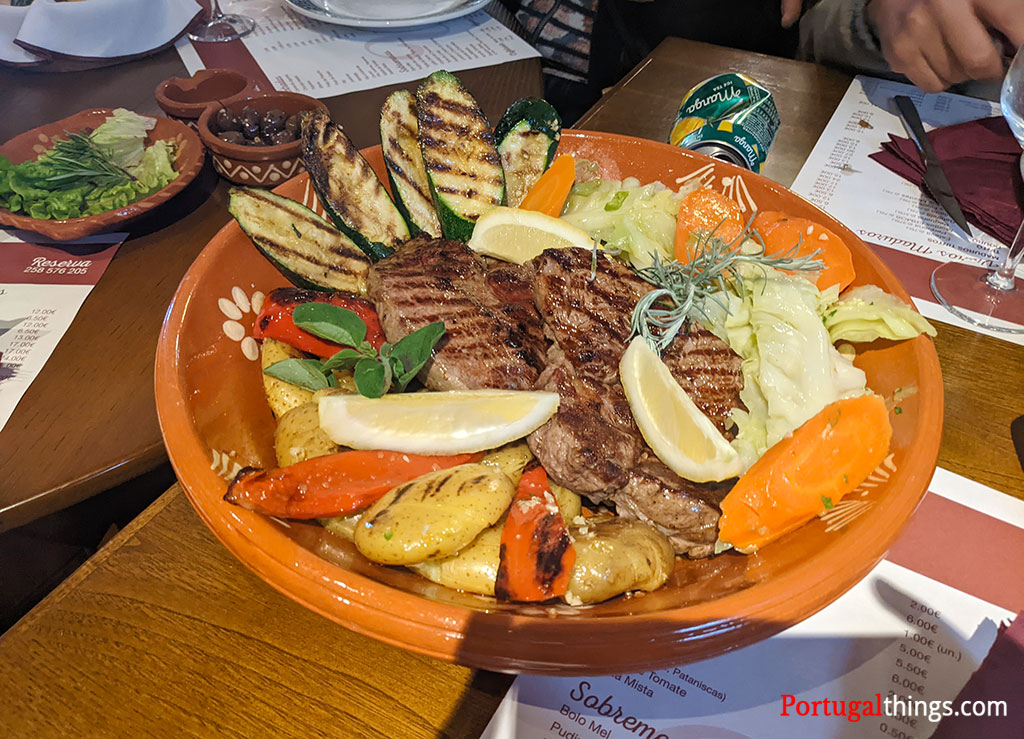
What to eat in Portugal
Starters / Appetizers – Food in Portugal
The most common starters or appetizers in Portugal are bread, sausages, smoked meats (such as chorizo, sausage, and ham), cheese, and olives. Sometimes, there are more complex starters such as codfish cakes, sausage, rissóis, and pâtés with toast.
Whenever you go to a restaurant in Portugal, you have some starters at your disposal, which are on the table or brought by the waiter. Bear in mind that these starters are not free. Some restaurants in other countries (like Mexico) offer them, but this is not the case in Portugal.
If you eat, you are charged. If you don’t, you are not. Unless there’s any mix-up or the rare dishonest restaurant, by law – “No dish, food product or drink, including the couvert, can be charged if it is not requested by the customer or consumed/unutilized.” Note that if you don’t want to eat anything, you can always tell the waiter that you don’t want the starters; it’s up to you.

Petiscos
Petisco is kind of the Portuguese version of the immensely famous Spanish “Tapas.” They are eaten in small quantities, serving as a drink accompaniment or light meal. They can be cold or warm. Petisco also has the informal meaning of something being very tasty. It also translates loosely to “snacks.”
Bolinhos de Bacalhau (cod fritters)
The Portuguese love cod – dry, not fresh. We have a thousand and one recipes with this ingredient. And one of the best ways to eat codfish is codfish fritters, one of the most traditional snacks in Portugal.
Codfish fritters (sometimes called cod cakes) are made with mashed potatoes, cooked and shredded dried codfish, chopped onion, eggs, and parsley. The ingredients are mixed into a uniform mass and shaped into balls or rugby balls. Finally, they are fried in oil.
They are very good, especially to eat on a summer day with a cold drink. For us, they are synonymous with picnic food, but you can find this snack in most snack bars and restaurants. If this is a Portuguese food you enjoy, the restaurant Manjar do Marquês along N1 road in Pombal is famous for it.

Gizzards (Moelas)
Moelas is one of the best snacks in Portugal. For us, it’s pure comfort food. They are made with chicken gizzards which are the viscera and offal of the bird. The gizzards are slowly cooked in a slightly spicy tomato sauce until soft. By the way, the secret of this recipe is the sauce.
The gizzards are eaten with bread to be dipped in the appetizing sauce. They can also be accompanied by rice and served as a main meal.
They are a typical snack in restaurants and snack bars in Portugal. Plus, it’s an easy recipe to make at home.

Bifanas
Bifanas is one of the typical snacks of popular festivals in Portugal, such as Santo António, São João and São Pedro. It is also one of the best sandwiches in Portugal.
It is said that the Bifanas were created in Vendas Novas in the Alentejo; they are sandwiches made with pork fever seasoned with garlic and a spicy sauce. Served on bread (small, round bread) and accompanied with mustard.
However, there are two types of bifanas in Portugal – Northern and Southern Bifanas. In the northern Bifanas, the meat is cut into extremely thin slices and cooked in a spicy sauce. They are served on a small bread called a molete, which has been dipped in the sauce.
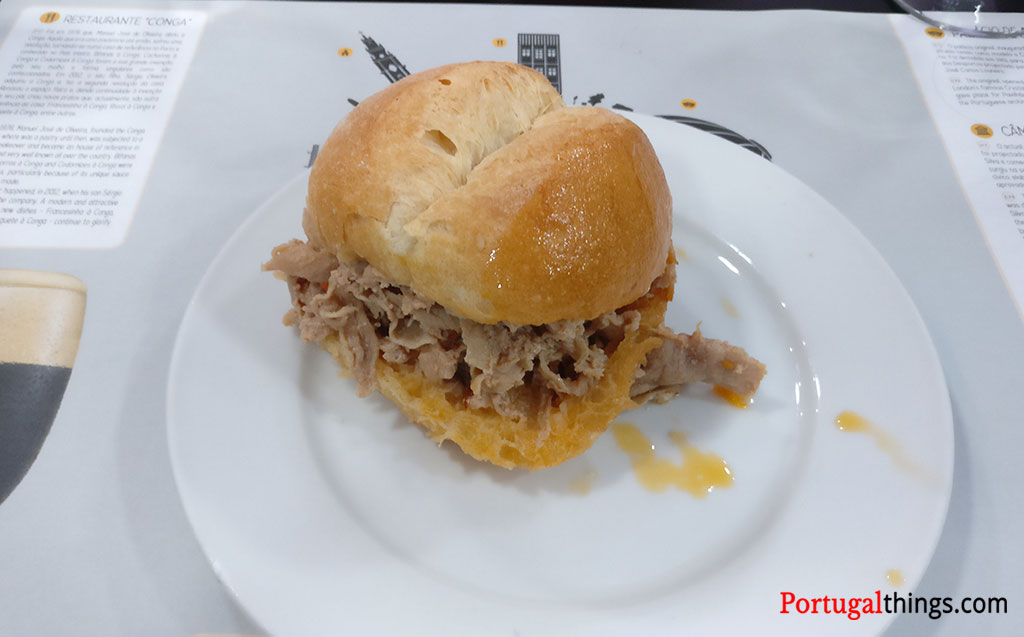
Bifanas from the south of Portugal are similar to those from Vendas Novas. They are made with a larger bread, the pork steak is thicker, and they are served like Mustard.
Both ones are delicious. You can find this snack in street food trucks, bars, or restaurants on National Road 4 in Vendas Novas, such as “Café Boavista” and “A Chaminé.”

Alheira
Alheira is a Portuguese sausage traditionally made with poultry, fat, and bread. But nowadays, there are alheiras made with other ingredients, such as pork and cod, and vegetarian options are also available. It needs to be cooked, usually fried with a bit of oil.
Alheira is a snack that originated in Trás-os-Montes but currently exists in other regions of Portugal. It is served as a starter or snack eaten with bread or plain. It exists in practically all the most traditional restaurants. You can also find them in any supermarket and cook them yourself. It’s pretty straightforward.
The origin of alheira is a curious story. It was created by Portuguese Jews who converted to new Christians in Portugal. To deceive the Inquisition, they created a sausage made with poultry rather than pork, as was traditional. Seeing them eating the sausage, people thought they were eating pork, confirming their renunciation of Judaism. Over time, alheira became popular with the entire population, becoming one of the most famous foods in Portugal.
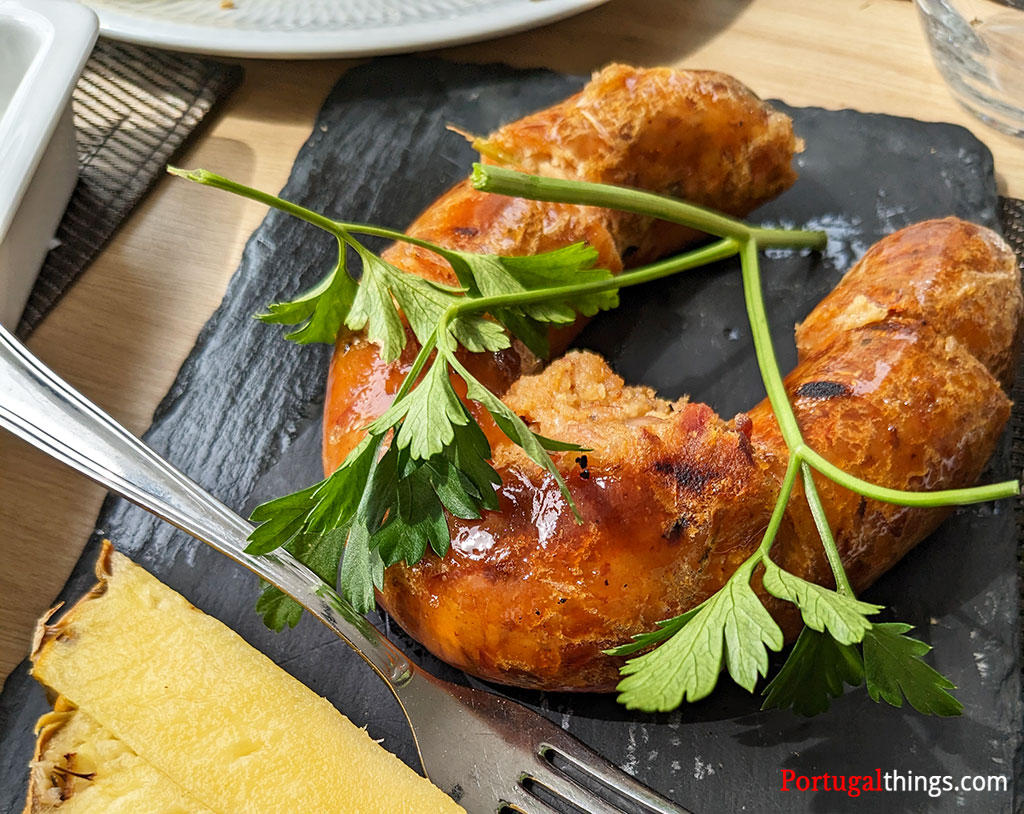
Pica-pau
Pica pau is a traditional snack that originated in Charneca do Ribatejo but can be found everywhere. It’s an excellent dish to share with friends and family on summer days, accompanied by a cold drink and slices of bread.
Pica pau can be made with different types of meat, but the most common is veal or pork. To make this dish, you have to fry the meat with garlic, a bay leaf and add white wine, mustard, salt, and pepper to taste. When the meat is cooked, add chopped pickles.
It is especially good to dip bread in meat sauce. This dish is available in many restaurants and snack bars in Portugal.
Soups – Portuguese dishes
Caldo Verde
Caldo Verde is the most famous soup in Portugal, and it is also available in other countries worldwide. It is a Minho soup from the North of Portugal.
It is made with Portuguese cabbage (not kale, but similar) cut into julienne strips (very finely), potatoes, onions, garlic, and sausage or chorizo. It is drizzled with olive oil and served with cornbread.
It is a comforting and flavorful soup. You can find it in almost every restaurant in Portugal, but especially in the North.

Canja (Chicken Soup)
Canja is the typical chicken soup that almost all countries have a version of – the Jews, Chinese, and French – essentially, all people have a soup like this. And nearly everyone believes in the healing miracles of a good chicken soup. So, it’s usually what you eat when you’re sick or have a cold.
Portuguese chicken soup is made with chicken (sometimes including giblets), chicken broth, and rice or pasta. It is traditionally eaten on Christmas Eve after midnight mass in Madeira. A bolo do caco (typical Madeiran bread) accompanies the sandwich with leftover chicken soup or meat in vinaigrette and garlic.
This soup is easy to find because it is served in many Portuguese restaurants.
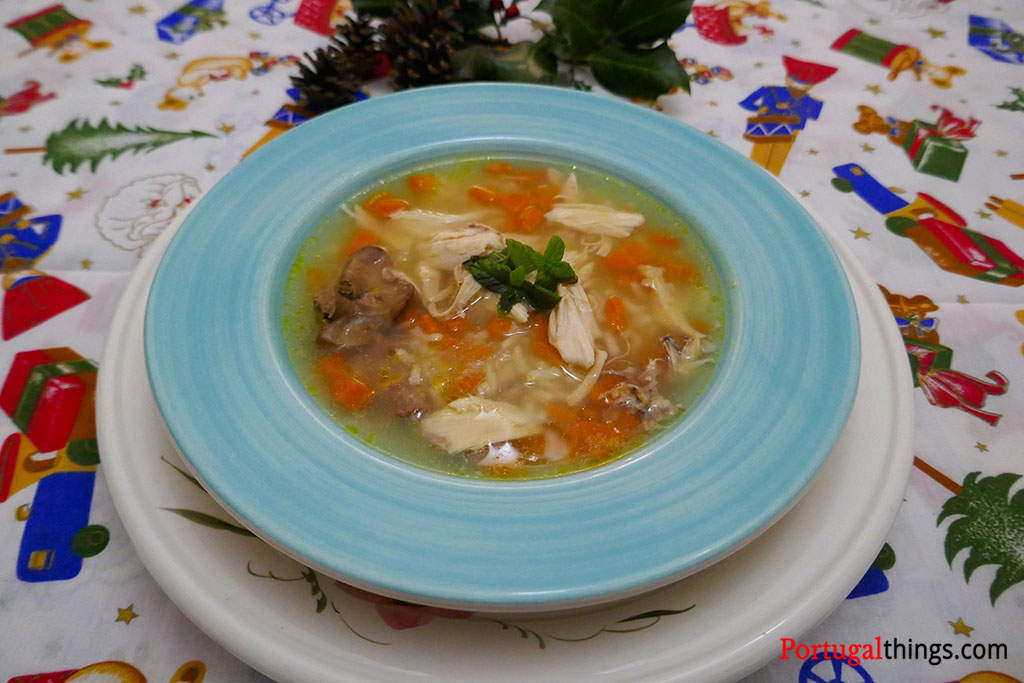
Sopa de Pedra (Stone soup)
As the name implies, this soup literally takes a stone. Sopa da Pedra originates from Almeirim, near Santarém, in the center/south of Portugal. In addition to the typical stone, the soup has several types of meats, chorizo, beans, cabbage, potatoes, and carrots. It’s a very rich soup (almost a stew) with a little bit of everything.
I suppose you are intrigued by the stone… Well, the stone comes from a legend that says that a pilgrim monk who was dying of hunger, when he arrived in the village, asked for just one stone to make a soup.
As he was going to make the soup, he asked for other ingredients to complete it. Intrigued, the inhabitants provided more and more ingredients, wanting to know how it would look. And so they, more or less, ended up with a very rich soup.
To honor the legend, the soup is still made with a stone. It is also served with exceptional bread made in Almeirim.
Unfortunately, it is difficult to eat this soup outside Almeirim. Or at least the fantastic version of local restaurants. But it’s so good that it makes you want to go there on purpose to have it again.

Açorda
Açorda is a soup or broth from Alentejo, created to make use of old Alentejo bread.
It is a simple soup with few ingredients. In addition to the bread, it has garlic, salt, coriander, or pennyroyal, and a poached egg on top of the broth. There are other versions of this soup with more ingredients, such as cod, fish, and purslane, but the traditional one is the simple one.
The soup is thought to have an Arab influence from when the Iberian Peninsula was under their rule. This soup is only available in Alentejo restaurants, it is very rare to find it in other parts of the country, especially in the north. In Lisbon, or close the Alentejo, it is occasionally served.
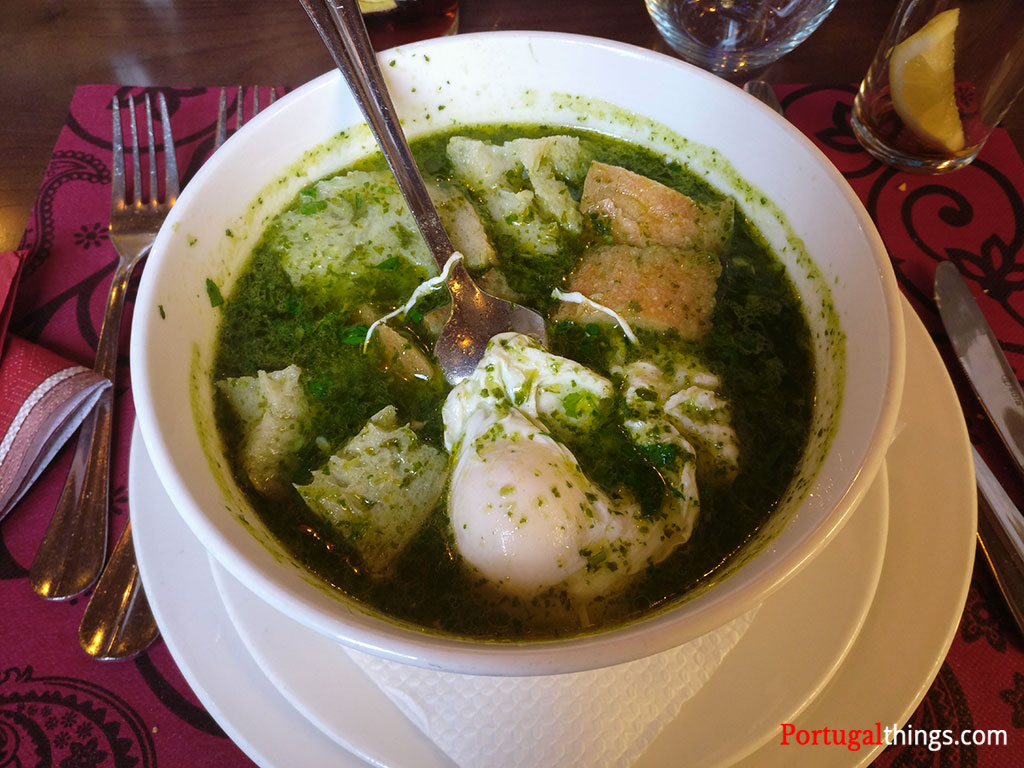
Fish and seafood dishes
Grilled fish
Portugal is one of the best places to eat fish in Europe. In addition to being fresh and of good quality, it is relatively inexpensive. However, remember that fresh fish is generally more expensive than other proteins.
In Portugal, the best way to eat fish is grilled whole. There’s nothing like eating freshly grilled fish. The most eaten fish in Portugal are sardines, horse mackerel, sea bass, and sea bream. In Madeira, people eat a lot of black scabbard fish, and in the Algarve, fresh tuna steaks. But there’s so much more.
The best places to eat fish are coastal towns and villages with strong fishing traditions. If you like things related to the sea and fishing, we recommend going to Mira and Nazaré, who still practice the Xávega Art – a traditional form of fishing – you can see when the fish is taken from the sea. It’s quite an exciting experience.
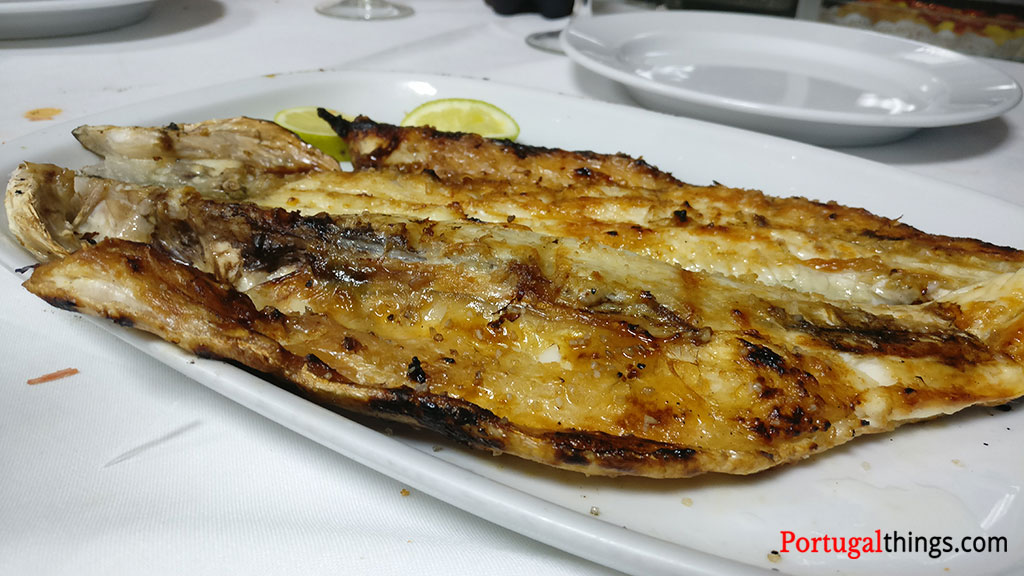
Grilled sardines
Sardines are one of the most typical and traditional dishes in Portugal. It is a food significantly associated with summer and popular festivals such as Santo António, São João and São Pedro.
Sardine fishing season runs from May to October. The best way to eat sardines is grilled, accompanied by boiled potatoes, cornbread, and roasted peppers drizzled with olive oil. Don’t be intimidated by the fishbones; you can easily remove them.
Several restaurants serve good grilled sardines in the coastal areas of Portugal. And, of course, you can find many sardines being grilled during popular festivals. During those times, sardines are a little more expensive, but that’s part of the fun of experiencing the Portuguese summer festivities.

Fish and Seafood Cataplana
The fish and seafood cataplana is a traditional dish from the Algarve and a delicious way to eat fish.
The dish’s name comes from the pot in which it is cooked, the cataplana, which has a very different shape. It is a copper container of Arab origin made up of two concave parts connected by a hinge that closes with the help of two side clasps.
This dish uses various types of fish and shellfish, such as ray, dogfish, conger fish, monkfish, shrimp, and clams. It also uses potatoes, onions, garlic, and sliced peppers. The ingredients are steamed slowly and hermetically sealed, retaining their flavor and aroma.
There are different types of fish, seafood, and even meat cataplanas. This dish should be eaten in the Algarve. It is tasty and has a dramatic effect due to the vehicle in which it is cooked and served.

Fried cuttlefish
Fried cuttlefish is a traditional dish from Setúbal found in almost all of the Portuguese coast. It consists of cuttlefish wrapped in egg and flour and fried in oil until golden and crispy. It’s a satisfying dish; the crunchy and tender cuttlefish is ideal. Cuttlefish are often served with equally delicious tomato rice.
Cuttlefish may resemble calamari, but they have different shapes and are meatier. If you like squid, you’ll definitely like fried cuttlefish.
The ideal place to eat fried cuttlefish with tomato rice is Setúbal, but this dish can also be easily found in some restaurants in Lisbon and elsewhere on the Portuguese coast.
You can also find a fried choquinhos dish, but the cuttlefish is not breaded, just lightly fried in olive oil with garlic and chili peppers. It’s different but not to be missed; it’s very delicious.

Polvo à Lagareiro (Lagareiro octopus)
Octopus à Lagareiro is one of the best dishes in Portugal, there’s no denying it. It is a dish made with octopus drizzled with lots of olive oil and garlic, accompanied by mashed potatoes. It’s to eat and cry for more.
To make this dish, you roast the octopus with plenty of olive oil, a lot of it, and garlic. It is accompanied by potatoes with skin that, when cooked, is lightly punched and then roasted. Octopus can take a long time to cook.
There are other dishes à lagareiro like cod à lagareiro. Lagareiro comes from the Portuguese word for mill (lagar – the place where olive oil is produced). Any ingredient cooked with hot oil and garlic is “à lagareiro”. For olive oil lovers, this isn’t an unmissable dish.
This dish is very associated with Trás-os-Montes, but it exists in almost all regions. Unfortunately, it is a costly dish, but it is expected since octopus is an expensive ingredient. And the amount of olive oil used doesn’t help. So when you see the price, don’t be too surprised; it’s just like that, a naturally expensive dish.

Bulhão Pato Clams
Bulhão Pato clams is one of the traditional Portuguese dishes perfect for the summer, as a light meal, or as a snack. It is a dish to slowly enjoy with good company and by the sea.
It is made with clams, which are sautéed with garlic, white wine, coriander, and lemon. They are served with slices of lemon and bread to dip in the delicious sauce.
You can find Bolhão Pato clams in many seafood restaurants, fish restaurants, and sometimes in some seaside snack bars. It is also an easy and quick recipe to make at home.
Arroz de Marisco (Seafood Rice)
Seafood rice is a very special dish in Portugal. It is usually associated with special occasions, such as birthdays or other special events.
It is a dish with various seafood, such as shrimp, clams, mussels, cockles, and sometimes lobster. The rice is cooked in a seafood broth, and the seafood is added at the end. It is a moist rice with a lot of seafood broth. It’s delicious.
It is a home-made dish that can be found in several fish and seafood restaurants in Portugal.

Cod Dishes – Portuguese culinary
Bacalhau à Brás
Bacalhau à Brás is one of the most common cod dishes in Portugal. It’s a simple dish, but very good, and is frequently found in Portuguese restaurants, often even served as the dish of the day.
It is a dish made with cooked and shredded dried codfish. The shredded codfish is mixed with eggs and shoestring potatoes. In the end, add more shoestring potatoes, parsley, and olives.
It’s a delicious combination: crispy fried potatoes, egg, and cod. This traditional dish is served in many restaurants in Portugal.
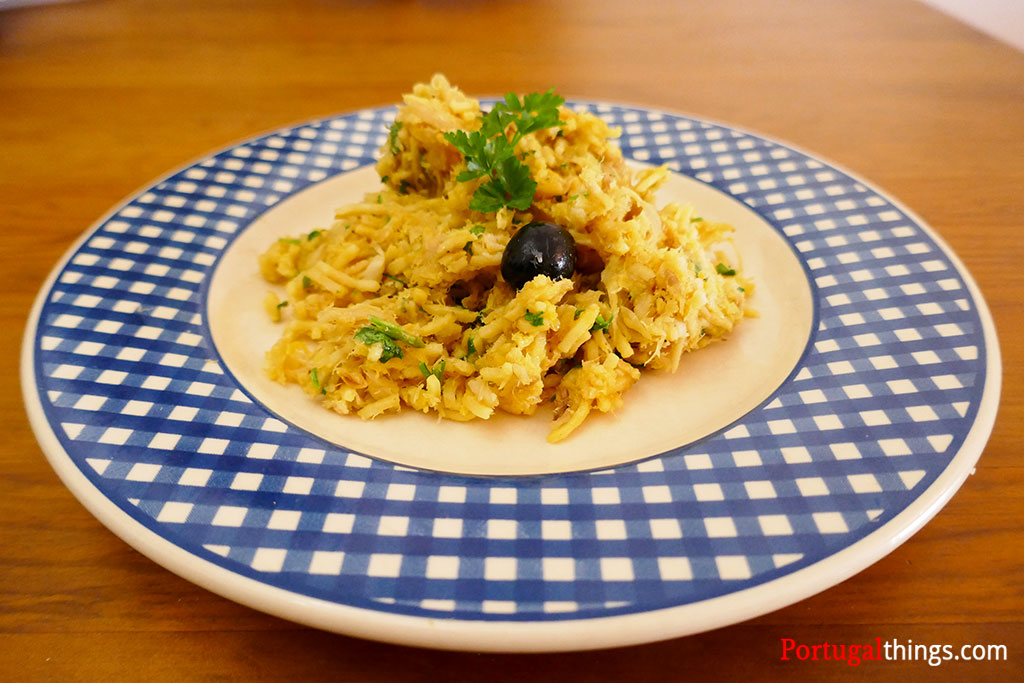
Bacalhau com todos
Cod with all is the traditional Christmas dish in Portugal. It’s a very simple dish, and even the Portuguese admit that it’s not the best way to eat cod, but it tastes like Christmas, the family, and it’s comforting. It’s tradition on a plate.
Cod with all, as the name implies, is cooked cod (all parts of cod) with boiled potatoes, boiled egg, Portuguese or Galician cabbage, and sometimes carrots and chickpeas. Ultimately, it is drizzled with an abundance of olive oil sauce with garlic.
It is an unusual dish in restaurants, but sometimes, you can find a simpler version called codfish stew. It is mainly cooked at home and typically served at Christmas and New Year’s.

Bacalhau com Natas (Cod with cream)
Bacalhau com Natas is one of those dishes everyone likes, even those who don’t like codfish. It is not one of the most traditional recipes in Portugal as it uses cream and Béchamel sauce, which are not common ingredients in more traditional/old Portuguese food.
This dish is made with cooked and shredded cod, diced or sliced potatoes, and sauteed onion. It is then topped with béchamel sauce and cream. Finally, it is covered with cheese and baked to gratin. With these ingredients, how can it not be delicious?
Despite not being the most traditional, it has gained popularity quickly and become one of the most frequent restaurant cod dishes. It is tasty and an excellent introduction to Portuguese codfish.
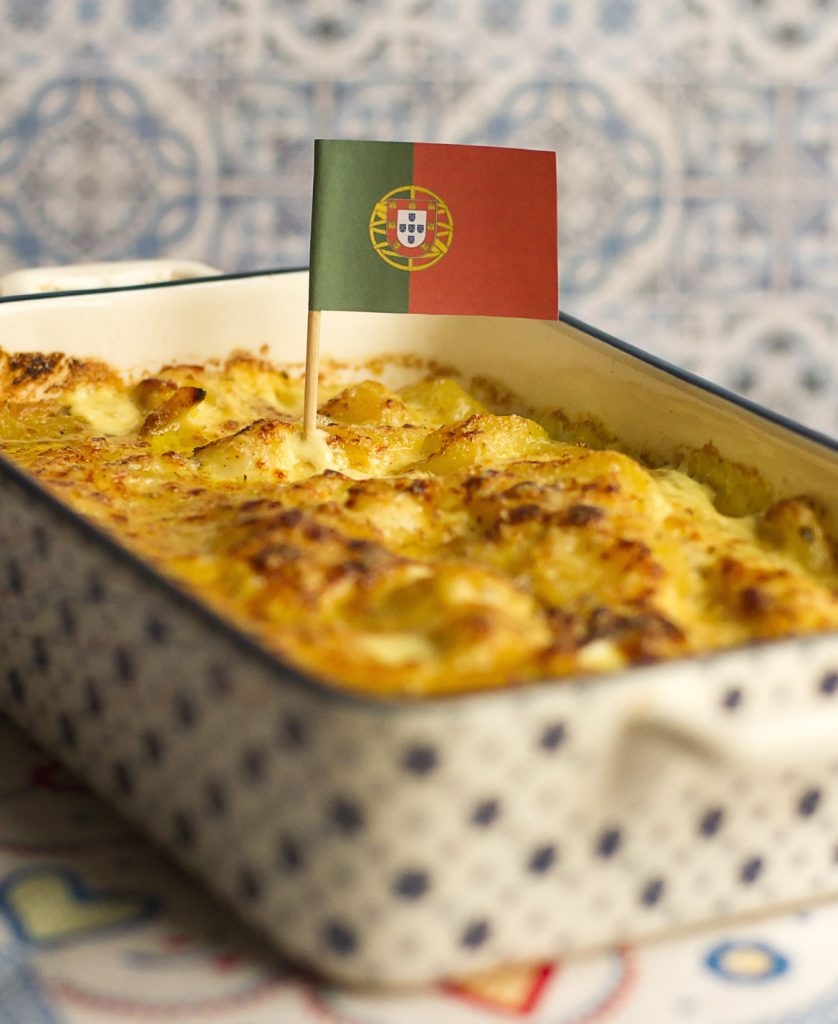
Bacalhau à Lagareiro (Cod lagareiro)
Bacalhau à Lagareiro is a classic recipe and one of the best ways to eat codfish. As we explained above, any “à lagareiro” recipe is made with a lot of olive oil. This cod dish involves baking the cod in the oven with a lot of olive oil, garlic, and a bay leaf.
To make this recipe, the best part of the cod is used – the loin – the steaks are thicker, so they have to be soaked well. It is served with roasted potatoes. The cod is moist and delicious, with a taste of olive oil and garlic. We advise you to dip the bread in the oil where the cod was roasted. Our mouths are watering just thinking about it.
It is a dish you can easily find in restaurants all over Portugal.
Bacalhau à Gomes de Sá
Bacalhau à Gomes de Sá is another iconic codfish dish. This Portuguese dish is made with shredded codfish (previously cooked) and onion and garlic sautéed, sliced, or diced potatoes (boiled). It is then baked to gratin and topped with boiled eggs and chopped parsley.
The recipe was created by José Gomes de Sá, a Porto cook who invented this cod recipe at the end of the 19th century, quickly becoming one of the most famous dishes in Portuguese cuisine.
It’s a delicious combination of flavors and a great way to eat codfish. This dish is easily found in Portuguese restaurants.

Meat dishes – Typical Portuguese food
Cozido à Portuguesa (Portuguese stew)
Besides Cod, Cozido à Portuguesa is Portugal’s most significant and traditional dish. It is a dish made with different pieces of meat, such as chicken, pork, chorizo, and black pudding. And vegetables like carrots, onions, cabbage, and turnips are slow-cooked with the meat. It is a more typical winter recipe and traditional in the interior and north of Portugal—the typical farmer’s dish.
It is a heavy meal because of the amount of meat, but also healthy, with plenty of vegetables and stews. It is a dish usually eaten at family gatherings and is comforting and pleasant.
Finding this Portuguese specialty in restaurants is not as easy as one would think. If you really want to try it, you should search specifically for it, as restaurants tend to only serve it by order or on Sundays.
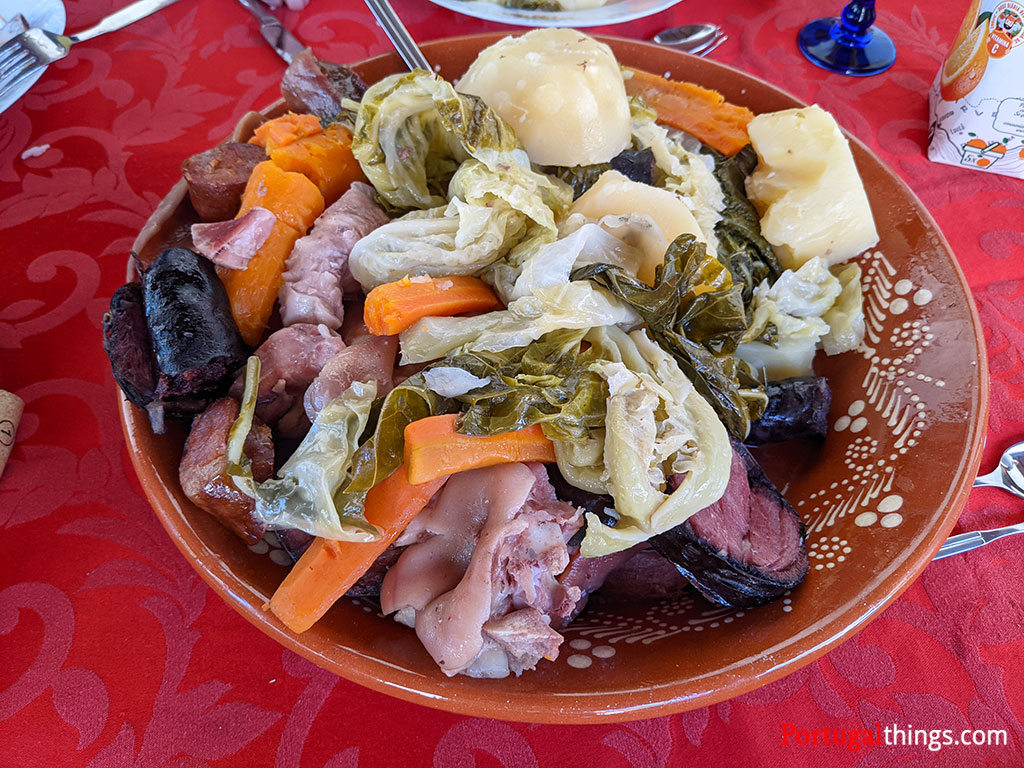
Feijoada à Transmontana
Feijoada à transmontana, as the name implies, is a traditional dish from Trás-os-Montes (northern Portugal). It is a very consistent and substantial bean stew dish – made with red beans (the main ingredient), different cuts of beef and pork such as ribs, ham, ears, tails, belly, and even various sausages such as chorizo and sausage and vegetables such as turnip greens, bunch and carrot.
It is traditional to eat feijoada on Domingo Gordo, the Sunday before Carnival, when we intend to eat a rich meal before the Easter fast.
It can be challenging to find feijoada à transmontana in restaurants, though some in Trás-os-Montes serve it. We recommend trying it as it is one of our favorite dishes. But we are lucky to know a cook who makes the perfect feijoada à transmontada.

Leitão à Bairrada
Leitão à Bairrada is an exotic typical Portuguese dish. The suckling pig (a small pig) is slowly roasted in a wood-fired oven. The suckling pig has very crispy skin but is very juicy.
Piglet has to be roasted in a certain way. Otherwise, it won’t turn out well. It’s not easy to do and involves technique and specs. That’s why it’s a mandatory dish to eat in specialized restaurants, especially in the Bairrada area, in Mealhada, which is undoubtedly the best place to eat suckling pigs. However, specialized restaurants exist in cities like Lisbon, Porto, etc.
It is served with french fries, oranges, and a spicy sauce made from pork fat. You can also eat suckling pig sandwiches, which are equally delicious.

Periperi chicken
Barbecue chicken is not a dish originally from Portugal, but the Portuguese love it. And there’s a grill on almost every corner.
The peri-peri chicken originates from Mozambique and Angola (ex., colonies of Portugal). It became very popular in Portugal when these countries became independent, and many Portuguese who returned to Portugal brought the recipe.
Barbecue chicken is charcoal-grilled chicken covered with a spicy Piri-piri sauce. However, the sauce is not very spicy in Portugal, and you can eat it without it.
This dish is easily found on barbecue grills. It’s one of those foods that is better prepared in a specialist restaurant than at home. Plus, it is the dish Portugal has the most similar to fast food.

Alentejo style pork
Carne de Porco à Alentejana is a little different from the typical Portuguese food because it mixes seafood and meat. It is made with pork meat, clams, garlic, paprika, wine, bay leaf, diced fries, and fresh coriander.
Despite being “à Alentejana” it is a dish from the Algarve, but it is common to find it all over Portugal, as it is so popular. The name origin has to do with the fact that pork from Alentejo is of the highest quality and is therefore indicated in this dish.
You can easily find this dish in any restaurant in Portugal, especially in Alentejo and Algarve.

Rojões
Rojões is a traditional dish from Minho, in the North of Portugal. It is made with sliced pork meat, garlic, and diced potatoes cooked in lard.
The meat has to be marinated in garlic vines, cumin, paprika, bay leaf, and salt the night before. Normally (but not always), the rojões are accompanied by floured tripe, liver, and fried blood. It’s usually served with potatoes and white rice.
It is a delicious dish, and you can find it in many restaurants in the North of Portugal; it is also an easy recipe to make.

Sweets and Dessert
Pastel de Nata
Pastel de Nata is the best-known pastry in Portugal, and there are even several versions of pastel de nata spread worldwide, such as in Macau and Malaysia.
Pastel de Nata is a conventual sweet that originates in convents and is made by nuns or friars. It is sweet with a crispy outer layer of puff pastry, filled with egg cream, and baked in the oven. On top, it is usually sprinkled with cinnamon and/or powdered sugar.
Note that there is a difference between Pastel de Nata and Pastel de Belém. Pastel de Belém is exclusively called the pastries sold by the “Antiga Pastelaria de Belém,” which is located in Belém right next to the Jerónimos Monastery. Pasteis de Nata are sold all over the country; they are very similar, but the Pastel de Belém recipe is their secret and original.
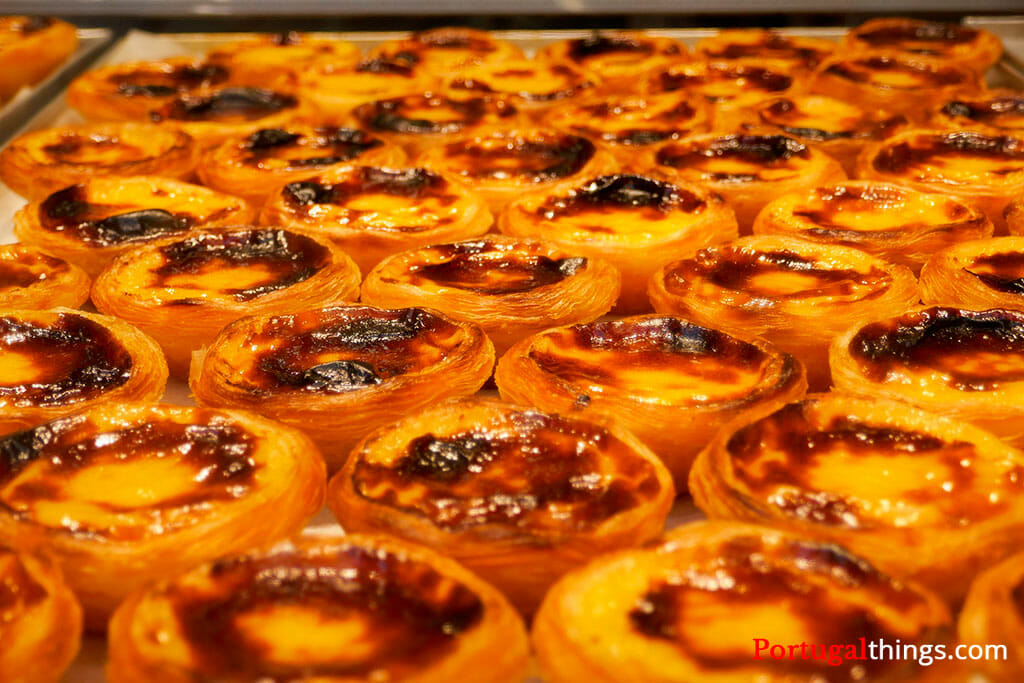
Pão de ló (Sponge cake)
Pão de Ló is another very famous sweet in Portugal – it is also a conventual sweet, and there are several versions of this cake, some drier, others moister. Some of the most famous sponge cakes are from Ovar, Alfeizerão, Arouca, Margaride, and Alpiarça.
It’s a simple cake made with flour, sugar, and eggs (lots of eggs). Pão de Ló is an ancient cake, with references to it dating back to the 18th century, and known as Pão de Castile.
Our favorite Pão de Ló is from Ovar, which is very moist, the interior being practically liquid. Anyone who likes sweet eggs will love this cake. There are drier versions in which it has the consistency of a fluffy cake that is very yellow due to the eggs, such as Pão de Ló of Margaride.
You can easily find this cake all over Portugal in pastry shops. In fact, almost every region in Portugal has a version of Pão de Ló.

Ovos Moles (Soft eggs)
Ovos Moles is a traditional sweet from Aveiro, which is made basically of egg yolks. You may have already noticed that traditional sweets in Portugal are made with eggs, especially the conventual sweets that are almost.
If you want to learn why you use abysmal amounts of egg yolks, see Conventual Sweets.
It’s a divine sweet, but you either love it or not because it’s basically just made from egg yolks and sugar. These are wrapped in hosts or placed in wooden or porcelain barrels and eaten with a spoon.
These sweets, despite having their origin in Aveiro as they are very traditional, can be found in several tourist areas in Portugal besides Aveiro. They are also one of the best souvenirs from Portugal, especially for foodies.

Queijadas
Queijada (loosely translates to cheesecakes) is a very common sweet in Portugal and is ideal for those who do not like sweets with a strong flavor. Although this sweet has many variations, the most common is made with fresh cheese, milk, egg, and sugar.
A wide variety of queijadas is made with other ingredients, such as almonds, oranges, curd, and many others. The most famous queijadas are from Sintra, Machico (in Madeira), Évora, Oeiras, and Pereira. But there is a wide variety of them.
As there are several variants, you can find this sweet in several pastry shops in Portugal, especially in Lisbon, but also in each of the places mentioned above.
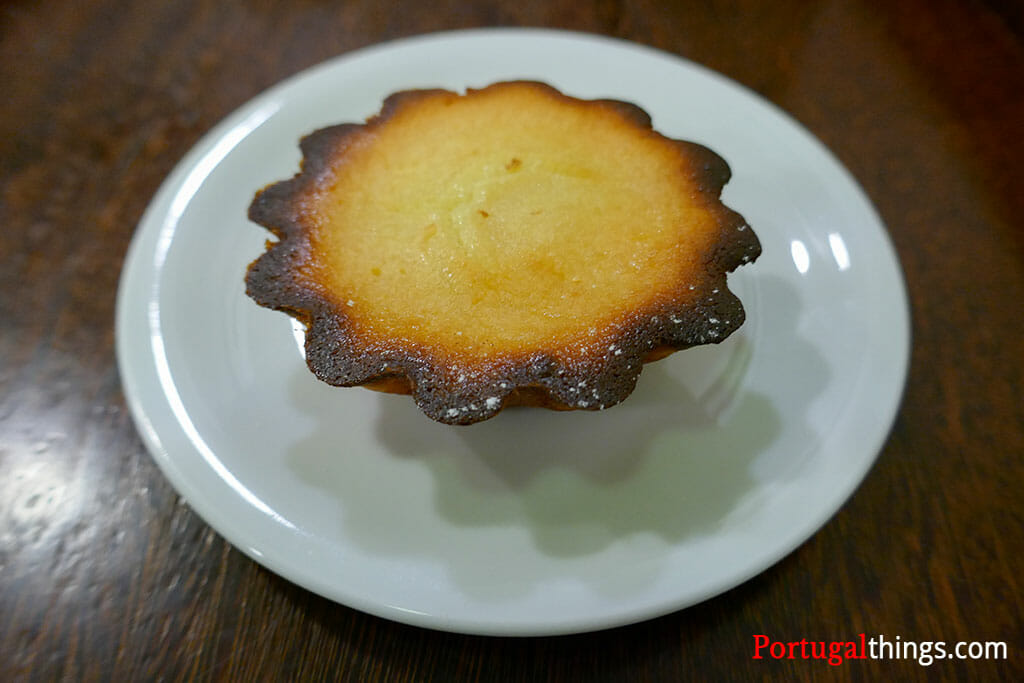
Bolo Rei (King Cake)
Bolo Rei is a traditional Christmas cake in Portugal. It’s a fruit cake, round with a hole in the middle. It has sweet dough, lemon, and orange zest, and a little port wine. In addition, it is covered and stuffed with plenty of dried and candied fruit.
It is mandatory to have this cake on the tables at Christmas. There are several variants of bolo-rei, such as bolo-rainha, bolo-rei escangalhado, and bolo-rei with chocolate, soft eggs, and even apple.
This cake is available in every pastry shop in the country, especially at Christmas, but it is also easily available outside the festive season.
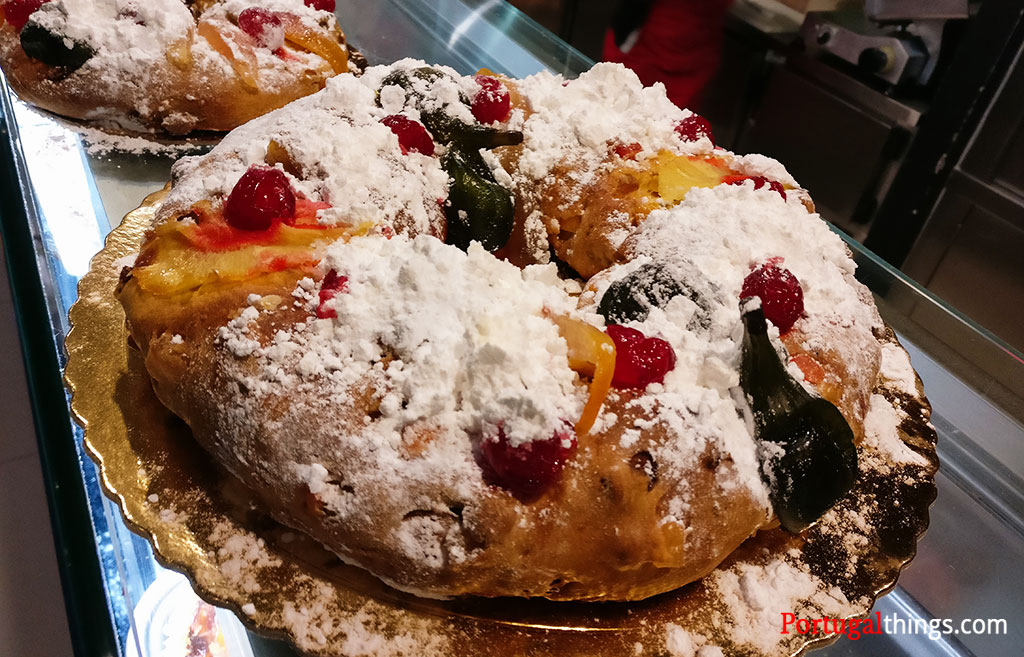
Egg pudding
Egg pudding is a delicious Portuguese dessert made in almost every Portuguese home. It is a dessert to eat with a spoon made with eggs, milk, lemon, or orange peel. It is made in a typical pudding pan that is covered in caramel.
Although very traditional in Portugal, there are also versions in Spain (Flan or Catalan cream) and France (Crème Caramel). There is a traditional version from Braga called Pudim Abade Priscos, which uses port lard in addition to the above-mentioned ingredients. It may sound strange, but it’s really good.
Egg pudding is a typical dessert in restaurants in Portugal, while Pudim Abade Prisco is less prevalent and is usually only found in Braga or the north of Portugal.

Conclusion – Portuguese food
This list is just a taste of what Portuguese gastronomy has to offer. There is so much to explore, and there are so many peculiarities of Portuguese food – and each region has its specialties and typical ingredients. The important thing is not to be afraid to experiment, ask questions, and explore. The Portuguese love food, and they love to share.
If you want to discover more about Portuguese gastronomy, we have several articles that explore various regional and seasonal dishes:
- What to eat in Porto? Typical Porto dishes not to be missed
- What to eat in Madeira?
- What to eat in Alentejo? 18 typical Alentejo dishes not to be missed
- What to eat in the Algarve? 19 Algarve Cuisine Dishes Not to Be Missed
- 15 Best Cod Recipes
- The wine regions of Portugal and their wines
- 10 Traditional Christmas Dishes in Portugal
- 20 best traditional Portuguese sweets and pastries
- 17 best desserts in Portugal
- Conventual sweets
- Types of Traditional Portuguese Bread
- Everything about Portuguese Olive Oil
*Cover Photo by asimojet via Depositphotos
Pin for later
